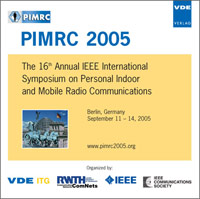Performance of a WCDMA FDD Cellular Multihop Network
Conference: PIMRC 2005 - 16th Annual IEEE International Symposium on Personal Indoor and Mobile Radio Communications
09/11/2005 - 09/14/2005 at Berlin, Germany
Proceedings: PIMRC 2005
Pages: 5Language: englishTyp: PDF
Personal VDE Members are entitled to a 10% discount on this title
Authors:
Karlsson, Robert S. (ZTE Wistron Telecom AB, Färögatan 33, 164 51 Kista, Sweden)
Aniktar, Huseyin; Mikkelsen, Jan H.; Larsen, Torben (Department of Communication Technology, Aalborg University, 9220 Aalborg Ø, Denmark)
Abstract:
Cellular multihop networks has the potential to decrease power consumption, increase coverage and/or enable higher data rates. We propose using in-band transmissions for the connection between a fixed repeating device and the cellular base station. A user connected via the repeater use one frequency band (fq2) for the communication to the repeater and the repeater uses an adjacent frequency band (fq1) for the communication to the base station. There is strong interference in the repeater due to transmitting and receiving on adjacent frequency bands, and strong interference from users connected directly to the base station on fq2. We demonstrate that the method can be used to introduce multihop functionality into a WCDMA FDD cellular system with only small changes. In a pessimistic scenario repeated users can lower their transmit power, but others have to increase their power. The multihop system requires no extra frequency spectrum but it has a small capacity penalty, and it requires a high adjacent channel leakage ratio in the repeaters. The results are reasonable for this pessimistic study and suggest further studies of alternative scenarios to improve the performance.


